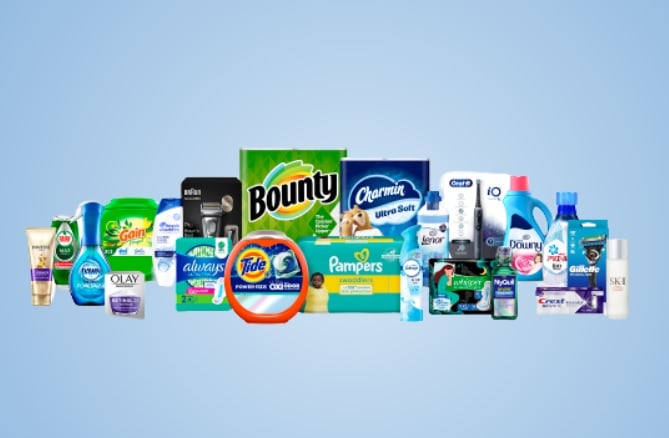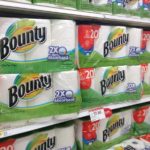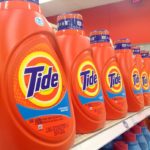There’s no longer a monthly P&G coupon insert in your Sunday paper, digital deals are sporadic, in-store promotions are fewer, and the company’s printable coupons still expire the day after you print them. Not to single out one manufacturer, but as the world’s largest consumer goods company, it could be said that as P&G goes, so goes the industry. And if that’s the case, it’s not ideal to be a deal-seeking shopper right now, as the industry seems to be saying that most shoppers are absorbing higher prices, shrugging off the fact that there are fewer promotions, and shopping just like they always have.
That may bode well for consumer confidence and the overall state of the economy, but not necessarily for your household budget.
P&G reported its latest quarterly earnings last week. While global sales volume declined 1% – meaning the company is selling fewer individual items – volume in the U.S. actually increased 3%, which means Americans are buying even more. And the global decline in sales was more than offset by higher prices on the products that the company is selling, which has helped to increase overall profits.
“The consumer continues to be remarkably resilient,” P&G Chief Financial Officer Andre Schulten told investors. “We haven’t seen a significant change in their preference yet. If anything, consumers that are choosing P&G products continue to trade up within our portfolio,” opting for even more expensive P&G products.
P&G is far from the only company that’s been raising prices. Manufacturers are feeling the impact of inflation, too, and are increasing prices to help cover their own costs. They’re also offering fewer deals. P&G says promotional pricing remains below pre-COVID levels. Back then, about 33% of P&G’s products were sold on some type of deal. Today, Schulten said, that percentage is about 29%. “And that makes sense,” he said, as manufacturers are “still recovering” from the higher commodity and supply chain costs that prompted them to raise prices in the first place.
Retailers often push for promotions from their suppliers, in order to provide them with deals to advertise and help get deal-seeking shoppers through their doors. But in response to P&G’s increased prices and declining promotions, “we have not experienced retailer pushback beyond normal discussions on how to maximize value for their shoppers and for consumers overall,” Schulten said. So “we don’t see a significant need to drive price promotion.” Promotion these days is more likely to come in the form of advertising, with the goal of driving “either trial or habit formation,” encouraging people to try a product and get them hooked, so they’ll keep buying no matter the price.
Part of the reason P&G is confident in that regard, is because of the types of products it sells. If your favorite cereal brand gets too pricey, you can stop buying that brand and pick something else. If your favorite brand of soft drink gets too expensive, you can quit buying soft drinks altogether. But P&G brands are largely in “daily-use categories that are nondiscretionary,” Schulten said, which is “serving us extremely well.” Products like toilet paper and detergent and toothpaste are necessities – you’re not really going to quit buying them or use less of them just because they’re getting too pricey.
You might, however, switch brands – after all, that 1% global sales volume decline represents real people declining to buy real products, whom P&G is losing as customers as they switch to other, cheaper brands. But P&G is betting that you won’t be happy with that cheaper brand’s quality. The company’s focus continues to be “investing in innovation” and quality, and communicating “the strength and the value that our brands can provide,” Schulten said. “We have gained even more confidence over the past two years that our strategy of pricing with innovation to drive superiority and create value for the consumer is working,” he continued. “We believe we are well set up to grow, even if the consumer feels a bit more of a pinch here going into the fall or winter season.”
Not every company can raise prices and lower promotional levels so confidently. Many manufacturers are suffering the consequences of higher prices and fewer deals, as price-sensitive shoppers switch to cheaper brands in record numbers – the latest figures show that sales of store-brand products now account one in five of all grocery purchases. “As P&G goes, so goes the industry” may hold true in a broad sense. But when it comes to relying on consumers’ apparent willingness to keep paying higher prices, inflation-weary shoppers may hope that the world’s largest consumer goods company is the exception rather than the rule.
Image source: Procter & Gamble

















what are they smoking … I myself havent not bought any p n g items last 3 years. To Jim’s comment,, most of the ibotta png at walmart you were not allowed to use a coupon with the rebate.. Hard pass. Arm and Hammer at walgreens is where its at! NO TY Png
The past year or so P&G been offering several deals in Ibotta which I imagine has been driving those sales. Right now there are many high value ones. I don’t recall it to this level pre-inflation. I’ve seen a $2.00 Ibotta cash back and also a $2.00 printable paper coupon on Febreze making the item $.31 cents after cash back or use of coupon. My first thought was they wouldn’t be doing this if they didn’t need to move product.
They’ve also offered a few buy $25.00 get $10.00 back that could be combined with cash back app offers. My first thought when I saw them was they were trying to drive sales and were feeling a ‘pinch’.
Additionally, it seems they’re doing more deals at Costco and Sam’s Club (by X amount of P&G products save X amount).
None of these promotions seem to be reflected in the article or the earnings report it mentions above.